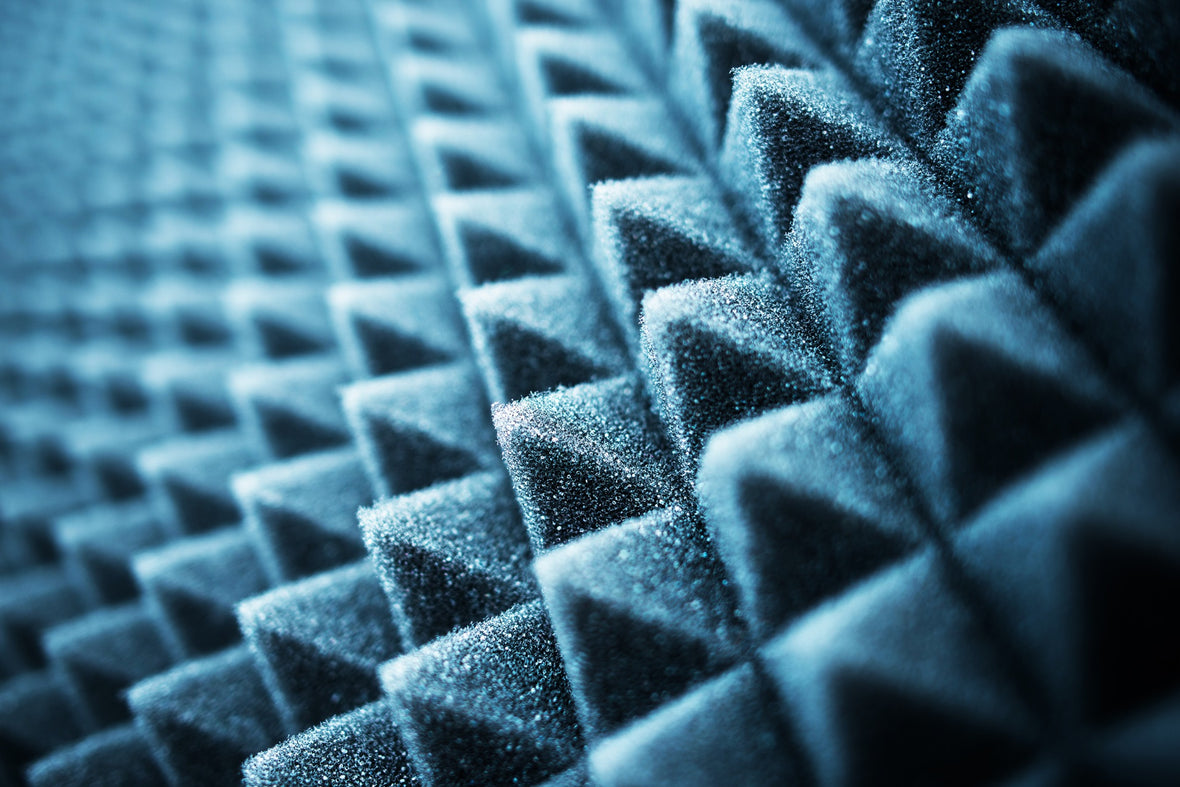
So wählen Sie den richtigen Akustikschaumstoff für Ihr Heimstudio
Shaun Snaith
Die Wahl des richtigen Akustikschaumstoffs für das Heimstudio kann für jeden Audio-Enthusiasten entscheidend sein. Klangqualität ist entscheidend, egal ob beim Mixen von Tracks, Aufnehmen von Podcasts oder Produzieren von Videoinhalten im eigenen Zuhause. Angesichts der großen Auswahl an Akustiklösungen ist es wichtig zu wissen, was diese Produkte leisten und warum sie für die Verbesserung Ihrer Aufnahmeumgebung unerlässlich sind.
Akustikschaum spielt eine entscheidende Rolle bei der Absorption unerwünschter Geräusche und Reflexionen, die Ihre Audioausgabe beeinträchtigen können. Ohne eine entsprechende akustische Behandlung können selbst die besten Mikrofone und Geräte Echos und Nachhall nicht verhindern, die die Klarheit und Detailtreue Ihrer Klänge beeinträchtigen.
Ganz gleich, ob Sie die Bassfrequenzen kontrollieren oder die Härte von Echos im mittleren Bereich reduzieren möchten: Wenn Sie die Nuancen der einzelnen Schaumstoffarten verstehen, verfügen Sie über das nötige Wissen, um fundierte Entscheidungen treffen zu können.
Was ist Akustikschaum und warum brauchen Sie ihn?
Akustikschaum ist ein schallabsorbierendes Material, das speziell entwickelt wurde, um die Raumakustik durch die Minimierung von Schallreflexionen und Echos zu verbessern. Dieser Spezialschaum reduziert den Geräuschpegel deutlich und verbessert die Klangqualität. Daher ist er unverzichtbar für Räume, in denen Klangqualität von höchster Bedeutung ist. Er besteht aus Polyurethan und absorbiert dadurch Schallfrequenzen, insbesondere im mittleren und hohen Frequenzbereich, effektiv.
In einem Heimstudio kann die Klangqualität den Unterschied zwischen Amateur- und Profiaufnahmen ausmachen. Eine gute Akustik sorgt dafür, dass unerwünschte Echos und Nachhall vermieden werden. Mit Akustikschaum verhindern Sie, dass diese Klangverzerrungen Ihre Aufnahmen beeinträchtigen.
Akustikschaum ist daher für professionelle Audioanwendungen unerlässlich und bietet Vorteile gegenüber anderen Schallschutzlösungen wie Teppichen oder Vorhängen, die in der Regel nur hohe Frequenzen absorbieren und die Gesamtklangqualität nur minimal beeinträchtigen. Darüber hinaus ist Akustikschaum effizient und kostengünstig und damit die beste Wahl für anspruchsvolle Audio-Enthusiasten.
Arten von Akustikschaum und ihre spezifischen Anwendungen
Dank der Vielfalt an heute erhältlichen Akustikschäumen gibt es für jeden Schallschutzbedarf die passende Lösung. Zu den gängigsten Typen gehören Pyramiden-, Keil- und Eierkarton-Schäume. Jeder Typ verfügt über einzigartige Eigenschaften, die auf unterschiedliche akustische Anforderungen zugeschnitten sind.
Pyramiden- und Keilschaumstoffe eignen sich hervorragend zur Kontrolle von Schallreflexionen und zur Reduzierung des Nachhalls. Die Pyramidenform bietet eine größere Oberfläche, die typischerweise mehr Schall absorbiert. Keilschaumstoffe mit ihren spitzen Rippen eignen sich hervorragend zum effektiven Auffangen und Zerstreuen von Schallwellen. Sie sind besonders nützlich in Umgebungen, in denen Gesangsaufnahmen stattfinden, da sie zur Erhaltung der Klangintegrität beitragen.
Eierkarton-Schaumstoff zeichnet sich durch seine unebene Oberfläche aus und streut Schall besonders gut, anstatt ihn zu absorbieren. Dies trägt zu einer ausgewogenen akustischen Umgebung bei, die sich ideal zum Mischen und Mastern eignet. Berücksichtigen Sie bei der Wahl des Schaumstoffs die spezifische Klangdynamik Ihres Heimstudios. Wenn Sie beispielsweise mit Problemen im Tieftonbereich zu kämpfen haben, sollten Sie dickeren und dichteren Schaumstoff wählen, da dieser im Vergleich zu leichteren Schaumstoffen besser zur Bassabsorption geeignet ist.
Berücksichtigen Sie bei Ihrer Wahl die Hauptnutzung Ihres Studios – ob Voiceover, Instrumentenaufnahmen oder umfassende Multimediaproduktion. Jeder Bereich stellt spezifische akustische Anforderungen und beeinflusst die Wahl des passenden Schaumstoffs. Dieser maßgeschneiderte Ansatz garantiert Ihnen den bestmöglichen Klang für Ihre Aufnahmen.
So bestimmen Sie die richtige Menge und Platzierung von Akustikschaum
Die richtige Menge und Platzierung von Akustikschaumstoff in Ihrem Studio kann die Klangqualität Ihrer Aufnahmen deutlich verbessern. Messen Sie zunächst Ihren Studioraum genau aus. Achten Sie besonders auf die Abmessungen von Wänden, Decke und anderen Bereichen, in denen Schall reflektiert wird. Die Berechnung dieser Abmessungen hilft Ihnen, die benötigte Schaummenge zu bestimmen, ohne zu unterschätzen oder zu überschätzen. So bleibt kein Bereich unbehandelt und Sie sparen Geld.
Die strategische Platzierung von Akustikschaum ist entscheidend für optimale Klangqualität. Beginnen Sie mit der Platzierung des Schaums an den ersten Reflexionspunkten, die sich typischerweise an den Wänden direkt neben und hinter den primären Schallquellen, wie z. B. Lautsprechern, befinden. Vergessen Sie nicht die Decke und die Ecken, da dort der Schall leichter reflektiert wird.
Mithilfe eines Spiegels können Sie diese Reflexionspunkte lokalisieren: Bewegen Sie den Spiegel einfach an der Wand entlang. Wenn Sie die Lautsprecher von einem beliebigen Punkt der Wand durch den Spiegel sehen können, sollten Sie dort eine Akustikplatte anbringen. Diese Technik gewährleistet eine Abdeckung an den kritischsten Stellen, verbessert die Klangqualität und reduziert unerwünschte Echos und Nachhall.
Aufrechterhaltung und Maximierung der Wirksamkeit Ihres Akustikschaums
Um sicherzustellen, dass Ihr Akustikschaumstoff dauerhaft optimale Leistung bringt, ist regelmäßige Pflege unerlässlich. Halten Sie den Schaum zunächst frei von Staub und Schmutz, da diese seine Absorptionsfähigkeit beeinträchtigen können. Sanftes Staubsaugen mit einem Bürstenaufsatz reicht in der Regel aus. Für eine gründlichere Reinigung eignet sich ein leicht mit Wasser angefeuchtetes, weiches Tuch. Vermeiden Sie jedoch unbedingt aggressive Chemikalien, da diese das Schaummaterial angreifen können.
Überprüfen Sie regelmäßig die Akustik Ihres Studios, insbesondere wenn Sie die Ausrüstung wechseln oder das Studio umbauen. Die akustischen Anforderungen können sich ändern, und zusätzlicher Schaumstoff oder andere Konfigurationen können für neue Instrumente oder Technologien erforderlich sein. Indem Sie diese Änderungen im Auge behalten und entsprechende Anpassungen vornehmen, sorgen Sie für eine optimale Aufnahmeumgebung. Regelmäßige Überprüfungen verhindern zudem, dass der Schaumstoff dauerhaft komprimiert oder beschädigt wird, und stellen sicher, dass er auch über Jahre hinweg seine optimale Leistung behält.
Optimieren Sie Ihren Heimstudio-Sound mit Akustikschaum
Egal, ob Sie ein angehender Musiker, ein etablierter Podcaster oder einfach jemand sind, der guten Sound liebt – die Ausstattung Ihres Raums mit den richtigen Schallschutzmaterialien kann den entscheidenden Unterschied machen. Es geht um mehr als nur darum, unerwünschten Lärm zu blockieren; es geht darum, einen Raum zu schaffen, in dem Klang harmonisch gedeihen kann.
Wenn Sie Ihre Klangumgebung verbessern möchten, entdecken Sie unsere Auswahl an Akustikschaumstoffen . Wir von Advanced Acoustics unterstützen Sie mit hochwertigen und zuverlässigen Schallschutzlösungen dabei, die bestmögliche Klangumgebung zu schaffen. Wir helfen Ihnen noch heute, die perfekte Akustiklösung für Ihren Raum zu finden!






